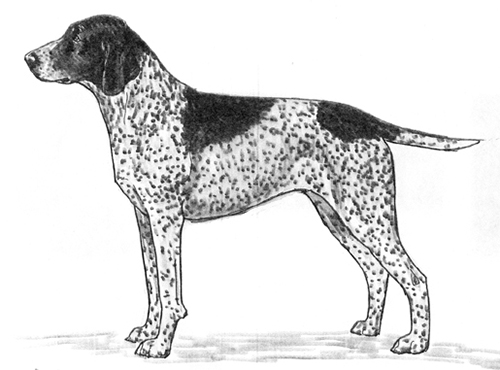Perdiguero de Burgos
Gun Dog Group
The goals and purposes of this breed standard include: to furnish guidelines for breeders who wish to maintain the quality of their breed and to improve it; to advance this breed to a state of similarity throughout the world; and to act as a guide for judges.
Breeders and judges have the responsibility to avoid any conditions or exaggerations that are detrimental to the health, welfare, essence and soundness of this breed, and must take the responsibility to see that these are not perpetuated.
Any departure from the following should be considered a fault, and the seriousness with which the fault should be regarded should be in exact proportion to its degree and its effect upon the health and welfare of the dog and on the dogs ability to perform its traditional work.
History
The Perdiguero de Burgos, or Spanish Pointer, is a large pointer that has contributed to the development of the other large pointing breeds. It has been in existence since the 1500s, and is thought to be descended from the Old Spanish Pointer and a Spanish scenthound. The breed was used as a specialist on deer for most of its history but today it is mainly used on quail, partridge and hare.
The Perdiguero de Burgos was recognized by the United Kennel Club January 1, 1996.
General Appearance
A hunting dog of good size, with a well developed head, pendulous ears, compact body and solid legs. It is short coated and square in proportion.
Characteristics
Calm and sedate, an excellent pointing dog used on fur and feather, with an excellent temperament and noble, soft expression.
Head
The head is large and powerful, with a well developed skull, a strong foreface and hanging corkscrew ears. The head is moderately rectangular seen from above, and narrows progressively towards the nose, but does not have a pointed muzzle. The skull is slightly longer than the muzzle and the planes of the skull and muzzle are divergent.
SKULL
Broad, rounded and convex in profile, with a well marked median furrow and a slightly marked occipital crest. The stop is a gentle slope.
MUZZLE
Straight in profile or slightly convex towards the nose, broad in its entire length.
TEETH
The Perdiguero de Burgos has a complete set of evenly spaced, white teeth meeting in a scissors bite.
Disqualifications: Undershot or excessively overshot.
NOSE
Dark brown, wet, large and wide.
Disqualifications: Split nose or black nose. Partial or complete lack of pigment of the nose.
EYES
Medium size, almond shaped, with tight lids and little or no haw. Color is preferably dark hazel, giving a soft, sometimes sad expression. Eyelids are fully pigmented, brown in color.
EARS
Set at eye level, large, hanging and triangular in shape. Without being drawn forward, they must meet the corner of the lips, but not the nose. At rest, the ears hang gracefully in a corkscrew. They are soft and limp with fine skin and hair.
Neck
Strong, powerful and slightly arched, with a double dewlap that starts from both corners of the lips.
Forequarters
The shoulder blade and upper arm are moderately sloping and equal in length.
FORELEGS
The legs are straight and parallel, with strong bone. The elbows are close to the body. The pasterns are strong and slightly sloping.
Body
Square, strong and robust, giving the impression of power and agility. The chest is broad and deep to the elbow, with a prominent sternum. The ribs are well developed and round. The withers are well defined, and the topline is strong and straight, with a slight downward slope towards the croup. The loin is broad and muscular. The croup is broad and sloping. The belly is moderately tucked up.
Hindquarters
The hindquarters are strong and muscular, with good bone. The angulation of the pelvis and the femur is approximately 100 degrees.
HIND LEGS
The upper thigh is very strong, with clearly defined musculature. The lower thigh is longer than the upper thigh. Angulation at the stifle is approximately 120 degrees. At the hock joint, it is blunter than 130 degrees.
Feet
Well knuckled up cat feet, with hard pads.
Tail
Thick at the root, set at medium height, generally docked to one half or one third its length.
Coat
Dense, short, smooth and evenly distributed all over the body.
Color
White and liver, irregularly patched or roaned. Often there is a distinct white patch on the forehead.
Disqualifications: Black coat color. Tan markings above the eyes or on the legs.
Height And Weight
Height at the withers for males is 24.5 to 26.5 inches. For females, it is 23 to 25 inches.
Gait
Typical gait is a steady, economical trot, flowing and powerful with no tendency to roll or amble.
Disqualifications
(A dog with a Disqualification must not be considered for placement in a conformation event, and must be reported to UKC.)
Unilateral or bilateral cryptorchid.
Viciousness or extreme shyness.
Albinism.
Undershot or excessively overshot.
Split nose or black nose.
Partial or complete lack of pigment of the nose.
Black coat color.
Tan markings above the eyes or on the legs.
The docking of tails and cropping of ears in America is legal and remains a personal choice. However, as an international registry, the United Kennel Club is aware that the practices of cropping and docking have been forbidden in some countries. In light of these developments, the United Kennel Club feels that no dog in any UKC event, including conformation, shall be penalized for a full tail or natural ears.

Looking for a Dog?
Find a dog that will fit your family.
Note: The breeders on this list are not endorsed by UKC.
Revised January 1, 2020. Additional description added to Eye section: little or no haw.
©Copyright 1996, United Kennel Club
